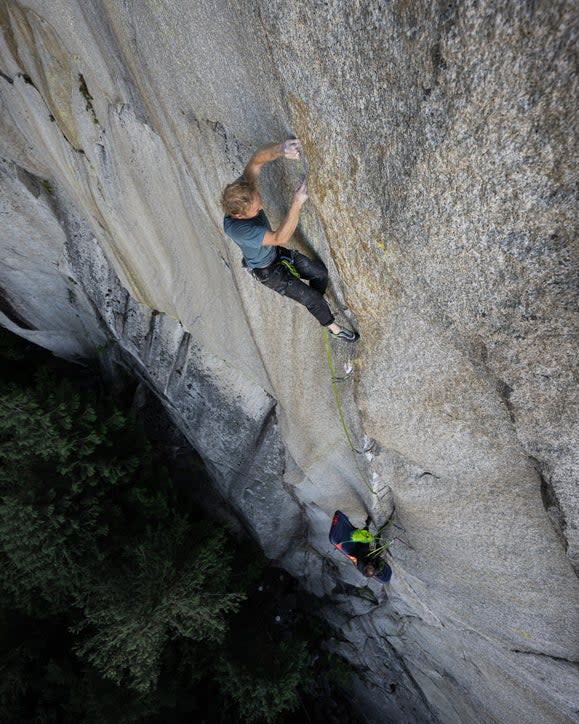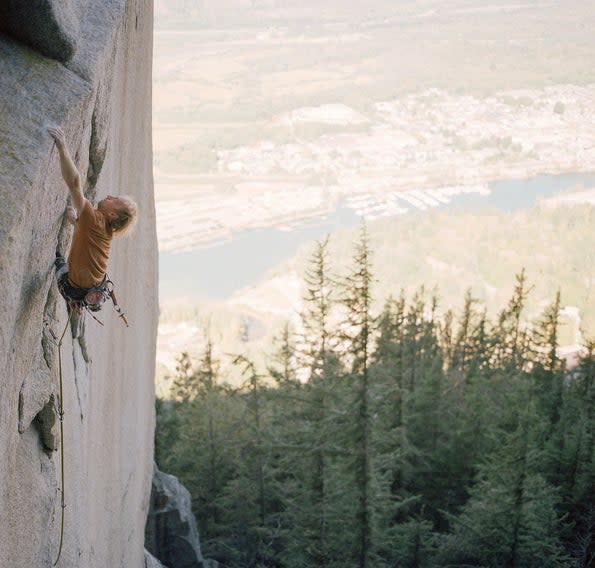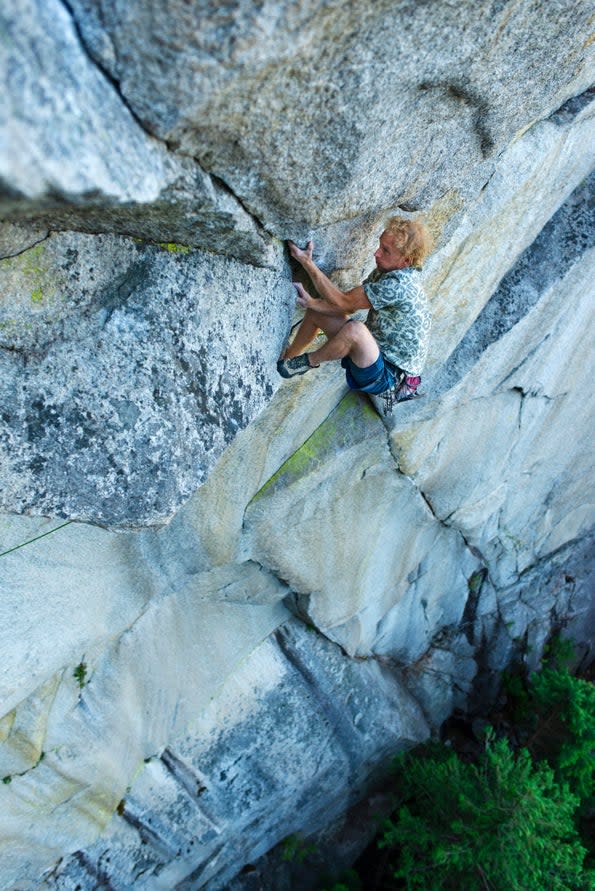Ben Harnden Nabs First (and Second!) Ascent of 5.14 Trad in Squamish
- Oops!Something went wrong.Please try again later.
This article originally appeared on Climbing
Canadian Ben Harnden has wrapped up an impressive first free ascent on Squamish's seldom-visited Kashmir Wall, which he has dubbed Bladerunner (5.14b/c)--though "maybe closer to C," he said. Harnden spent over 25 days working the crux pitch and had all but given up when he happened to unlock the key sequence: a "very high" left foot and a V12 huck to a distant sloper.
After finding this critical beta, Harnden continued to work the pitch headpoint style and refined his sequences. "Eventually, obviously, I went to lead it, and it was just a process of switching gears and getting used to climbing on the sharp end," Harnden told me. "It's clean air--you're not going to hit a ledge--which always makes it mentally easier." Harnden used a twin-rope configuration to protect himself from a sharp arete low on the pitch and began giving lead attempts. He sent after "eight or 10" lead goes, then returned a few days later with photographer Tempei Takeuchi and sent it again.

Harnden is well known in the Canadian climbing world; he made the third ascent of Dreamcatcher (5.14d) and has ticked all-gear lines including Cobra Crack (5.14), The Bull (5.14 R), and Family Man (5.14). At a glance, Bladerunner looks equally as stunning as any of those routes, so I caught up with Harnden by phone to learn more. This interview has been edited for clarity and length.
The Interview
Climbing: What's the history of this line?
Harnden: Bladerunner was an A2+ aid line put up by John Furneaux and Pat Delaney in 2000. It's been on my radar for a potential free climb for the last five or six years. I believe Sonnie Trotter and Will Stanhope bolted the exit pitch, which I used. The route climbs the first two pitches of Bladerunner and then cuts out right to the exit of the Fangdangler, so Bladerunner is like a zig zag. I started trying to free it last year, and have been plugging away since then.
Climbing: What's the pitch breakdown?
Harnden: The route I did is three pitches: 5.12+, 5.14, and 5.11a exit.
Climbing: You wrote that this project took you over 25 days. What did your progression on Bladerunner look like?
Harnden: I definitely used a headpoint style. I had a fixed line on the route for a while, and I think I spent at least 10 or 15 days just trying the crux sequence--I couldn't figure it out. It was a very cryptic sequence. I treated the moves like a boulder problem: just staring at it and trying to figure out different sequences. I was just about to give up on it actually: One day I headed up just to clean up the fixed lines and I ended up figuring out the very last move, which was a high--very high--left foot to a dynamic throw to a ledge. Well, not really a ledge ... a slopey rail. It was a pretty dynamic finish.

Climbing: I know you called the pitch 5.14c--is it sustained, or more like a boulder problem bookended by easier climbing?
Harnden: It's a 20-meter pitch and definitely sustained: you're climbing on small cams and very fragile feet and there's some dangerous fall potential with a rope going over an edge. So it's sustained in the psychological sense. [Laughs.] And it is quite physically sustained, too. I'd say it's a V8 or 9 into a V12.
Climbing: What sort of gear were you placing?
Harnden: I placed a gray Alien, a blue-green Alien, a 00 C3, a green Alien, yellow-gray Alien, and another 00 C3, and a red C3. So pretty small cams.
Climbing: And why did you choose to use twin ropes instead of a single?
Harnden: The pitch starts from a belay in a little corner feature, where you place some cams and then roll over this steep and exposed arete and climb up it. I took one whipper and I could see the rope just start to slice on that corner. On my next go I used two ropes.

Climbing: Did the pitch go down pretty quickly on lead?
Harnden: It took about 8 or 10 lead goes. Each session I had two lead goes, maybe three, but that was it. My head space usually had had enough after two.
Climbing: Did you enjoy sending Bladerunner more the first time or the second time?
Harnden: The second time was a little bit smoother, for sure. But both were enjoyable. The beta was still fresh in my mind, which was a bonus, and it was great to experience the route again. Because, you know, you put so much work into something and then all of a sudden you do it and it's almost anticlimactic ... so it was nice to climb it again. It felt like a routine.
Anthony Walsh is a digital editor at Climbing.
Also read:
For exclusive access to all of our fitness, gear, adventure, and travel stories, plus discounts on trips, events, and gear, sign up for Outside+ today.


